|
|
|
|
|
|
|
 |
|
QUESTION 1
|
|
|
|
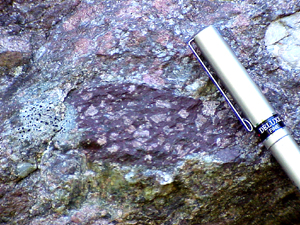 Rhyolite- a reddish volcanic rock that is fine grained overall. However, note that some rhyolites contain coarse feldspars called "phenocrysts" that are included in the fine maroon rock as in the picture at left. This is a clue to the cooling/crystallization process. While the molten rock was still underground before it erupted, it cooled slowly allowing the coarse phenocrysts to grow. Then, the lava erupted, dragging with it the early formed phenocrysts. Once on the surface, the lava cooled very quickly forming the fine maroon rock that you see. Rhyolite- a reddish volcanic rock that is fine grained overall. However, note that some rhyolites contain coarse feldspars called "phenocrysts" that are included in the fine maroon rock as in the picture at left. This is a clue to the cooling/crystallization process. While the molten rock was still underground before it erupted, it cooled slowly allowing the coarse phenocrysts to grow. Then, the lava erupted, dragging with it the early formed phenocrysts. Once on the surface, the lava cooled very quickly forming the fine maroon rock that you see. |
|
|
|
|
|
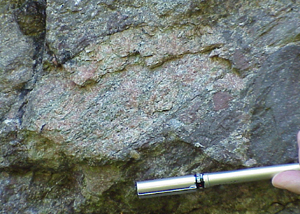 Granite - a coarse-grained igneous rock with pink K-feldspar, quartz and plagioclase. This rock represents magma that cooled and crystallized entirely underground forming a rock of entirely coarse grains. The texture of granite is typically a coarse, unlayered "phaneritic" texure. This particular sample is from the "granitic" formation called the Cranberry Gneiss, and is a billion years old, among the oldest rocks in the Appalachians! Those of you who know your metamorphic rocks know that a "gneiss" is typified by layering. In most of the area surrounding Mount Rogers, the Cranberry Gneiss is predominantly a metamorphosed granite, giving it a metamorphic layering which is a throwback to the building of the Appalachians during the Paleozoic. The Mount Rogers area is remarkable in that most of the rocks here have escaped the effects of the Paleozoic metamorphism, so many of the Cranberry pieces here still preserve much of its original texture. An important point: if you see feldspar in a sedimentary rock like this conglomerate, it usually means that the source of the sediment is not far from its site of depostion because feldspar tends to break down fairly quickly once it gets exposed to air and moved in water. Granite - a coarse-grained igneous rock with pink K-feldspar, quartz and plagioclase. This rock represents magma that cooled and crystallized entirely underground forming a rock of entirely coarse grains. The texture of granite is typically a coarse, unlayered "phaneritic" texure. This particular sample is from the "granitic" formation called the Cranberry Gneiss, and is a billion years old, among the oldest rocks in the Appalachians! Those of you who know your metamorphic rocks know that a "gneiss" is typified by layering. In most of the area surrounding Mount Rogers, the Cranberry Gneiss is predominantly a metamorphosed granite, giving it a metamorphic layering which is a throwback to the building of the Appalachians during the Paleozoic. The Mount Rogers area is remarkable in that most of the rocks here have escaped the effects of the Paleozoic metamorphism, so many of the Cranberry pieces here still preserve much of its original texture. An important point: if you see feldspar in a sedimentary rock like this conglomerate, it usually means that the source of the sediment is not far from its site of depostion because feldspar tends to break down fairly quickly once it gets exposed to air and moved in water. |
|
|
|
|
|
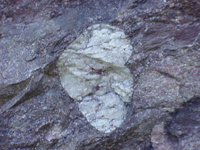 Milky quartz - typically found in areas of igneous and metamorphic rocks, they often originate as veins that fill cracks in the bedrock. The picture at left is a cobble composed of a milky quartz, which was originally part of a vein that had been exposed, rounded during transportation, and then deposited and re-buried, as a component of te Mount Rogers Formation. Because of its resistance to weathering, vein quartz is very common as stream pebbles in the Blue Ridge, withstanding far more wear-and-tear than other rock types. Milky quartz - typically found in areas of igneous and metamorphic rocks, they often originate as veins that fill cracks in the bedrock. The picture at left is a cobble composed of a milky quartz, which was originally part of a vein that had been exposed, rounded during transportation, and then deposited and re-buried, as a component of te Mount Rogers Formation. Because of its resistance to weathering, vein quartz is very common as stream pebbles in the Blue Ridge, withstanding far more wear-and-tear than other rock types. |
|
|
|
|
|
|
|
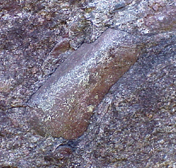 Sandstone - sedimentary rock, composed of various other rocks and minerals derived from the weathering and erosion (transport) of other pre-existing rock units. The pboto at right shows a piece of sandstone, well rounded from transport in a stream, which was derived from rock formed from the weathering and erosion of even older rocks. Sandstones are very often instrumental in "unravelling" geologic history, as they preserve the materials found in the rocks before them. Sandstone - sedimentary rock, composed of various other rocks and minerals derived from the weathering and erosion (transport) of other pre-existing rock units. The pboto at right shows a piece of sandstone, well rounded from transport in a stream, which was derived from rock formed from the weathering and erosion of even older rocks. Sandstones are very often instrumental in "unravelling" geologic history, as they preserve the materials found in the rocks before them. |
|
|
|
|
|
|
|
|
 Greenstone - appears here as a greenish-gray fine grained rock, with an ever-so-slight layered look caused by metamorphism. This rock is metamorphosed basalt, formed from lava flows in the area which were later eroded, buried, and then metamorphosed. We will see more examples of this at Stop 4. Greenstone - appears here as a greenish-gray fine grained rock, with an ever-so-slight layered look caused by metamorphism. This rock is metamorphosed basalt, formed from lava flows in the area which were later eroded, buried, and then metamorphosed. We will see more examples of this at Stop 4. |
|
|
|
|
|
|
|
|
|
|
|
QUESTION 2
|
|
|
|
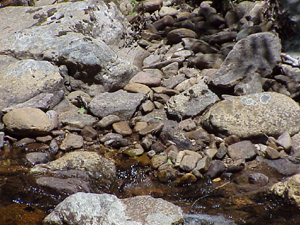 Turn around and take a look at the stream that runs along the road. Do the cobbles in the stream remind you of what is in the outcrop? This is a fast-moving mountain stream . Rocks in the stream are smoothed into a rounded shape by being knocked around and by the impacts of other sediment grains. Note that the rocks rest on each other. If this mountain stream is lucky, the water will slow down and cover the cobbles with finer sediment, thus burying and preserving what you see. Compare by observing the photos to the left, which is a present-day stream, and the photo below, taken at the outcrop. And, here's an interesting "factoid": if you look carefully, you'll even notice that the rocks are often "imbricated", or stacked at an angle in the dirction of the flow of the water. This is often important in determining the directions of ancient streams in rocks that are preserved as sedimentary formations. Turn around and take a look at the stream that runs along the road. Do the cobbles in the stream remind you of what is in the outcrop? This is a fast-moving mountain stream . Rocks in the stream are smoothed into a rounded shape by being knocked around and by the impacts of other sediment grains. Note that the rocks rest on each other. If this mountain stream is lucky, the water will slow down and cover the cobbles with finer sediment, thus burying and preserving what you see. Compare by observing the photos to the left, which is a present-day stream, and the photo below, taken at the outcrop. And, here's an interesting "factoid": if you look carefully, you'll even notice that the rocks are often "imbricated", or stacked at an angle in the dirction of the flow of the water. This is often important in determining the directions of ancient streams in rocks that are preserved as sedimentary formations. |
|
|
|
|
|
|
|
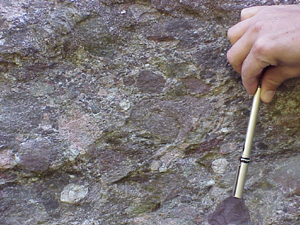 |
|
|
|
|
|
QUESTION 3
|
|
|
|
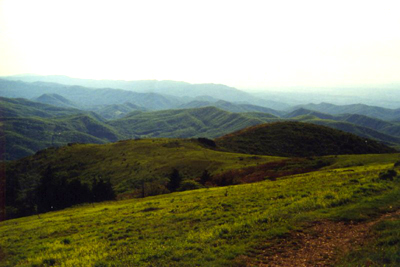 Look around - what topography do you see here? The landscape in the late Proterozoic was probably similar to what we see now: mountainous, like the photo seen above, with fast-moving streams going down steep gradients. The various rock types were all most likely locally derived from erosion of the bedrock. Since the Mount Rogers Formation contains many volcanic rocks like the cobbles seen in the outcrop, it is likely that the volcanoes had erupted shortly before the conglomerate was made. Thus some of the mountains might have been volcanic. Also note: the granite pieces are from the underlying basement rock here, the Cranberry Gneiss. Thus, some of the land was also composed of raised areas of basement. What we see looking at the stream by the road is history being made. Someday, what you see now will be the components for some future conglomerate! Look around - what topography do you see here? The landscape in the late Proterozoic was probably similar to what we see now: mountainous, like the photo seen above, with fast-moving streams going down steep gradients. The various rock types were all most likely locally derived from erosion of the bedrock. Since the Mount Rogers Formation contains many volcanic rocks like the cobbles seen in the outcrop, it is likely that the volcanoes had erupted shortly before the conglomerate was made. Thus some of the mountains might have been volcanic. Also note: the granite pieces are from the underlying basement rock here, the Cranberry Gneiss. Thus, some of the land was also composed of raised areas of basement. What we see looking at the stream by the road is history being made. Someday, what you see now will be the components for some future conglomerate! |
|
|
|
|
|
|
|
|
|
|
|
 |
|
 |
 |
|
 |
 |
 |
|
|
|
|
|
|
|
|
|
|
|
|
|
|
|
|
|
|
|
|
 Look around - what topography do you see here? The landscape in the late Proterozoic was probably similar to what we see now: mountainous, like the photo seen above, with fast-moving streams going down steep gradients. The various rock types were all most likely locally derived from erosion of the bedrock. Since the Mount Rogers Formation contains many volcanic rocks like the cobbles seen in the outcrop, it is likely that the volcanoes had erupted shortly before the conglomerate was made. Thus some of the mountains might have been volcanic. Also note: the granite pieces are from the underlying basement rock here, the Cranberry Gneiss. Thus, some of the land was also composed of raised areas of basement. What we see looking at the stream by the road is history being made. Someday, what you see now will be the components for some future conglomerate!
Look around - what topography do you see here? The landscape in the late Proterozoic was probably similar to what we see now: mountainous, like the photo seen above, with fast-moving streams going down steep gradients. The various rock types were all most likely locally derived from erosion of the bedrock. Since the Mount Rogers Formation contains many volcanic rocks like the cobbles seen in the outcrop, it is likely that the volcanoes had erupted shortly before the conglomerate was made. Thus some of the mountains might have been volcanic. Also note: the granite pieces are from the underlying basement rock here, the Cranberry Gneiss. Thus, some of the land was also composed of raised areas of basement. What we see looking at the stream by the road is history being made. Someday, what you see now will be the components for some future conglomerate!